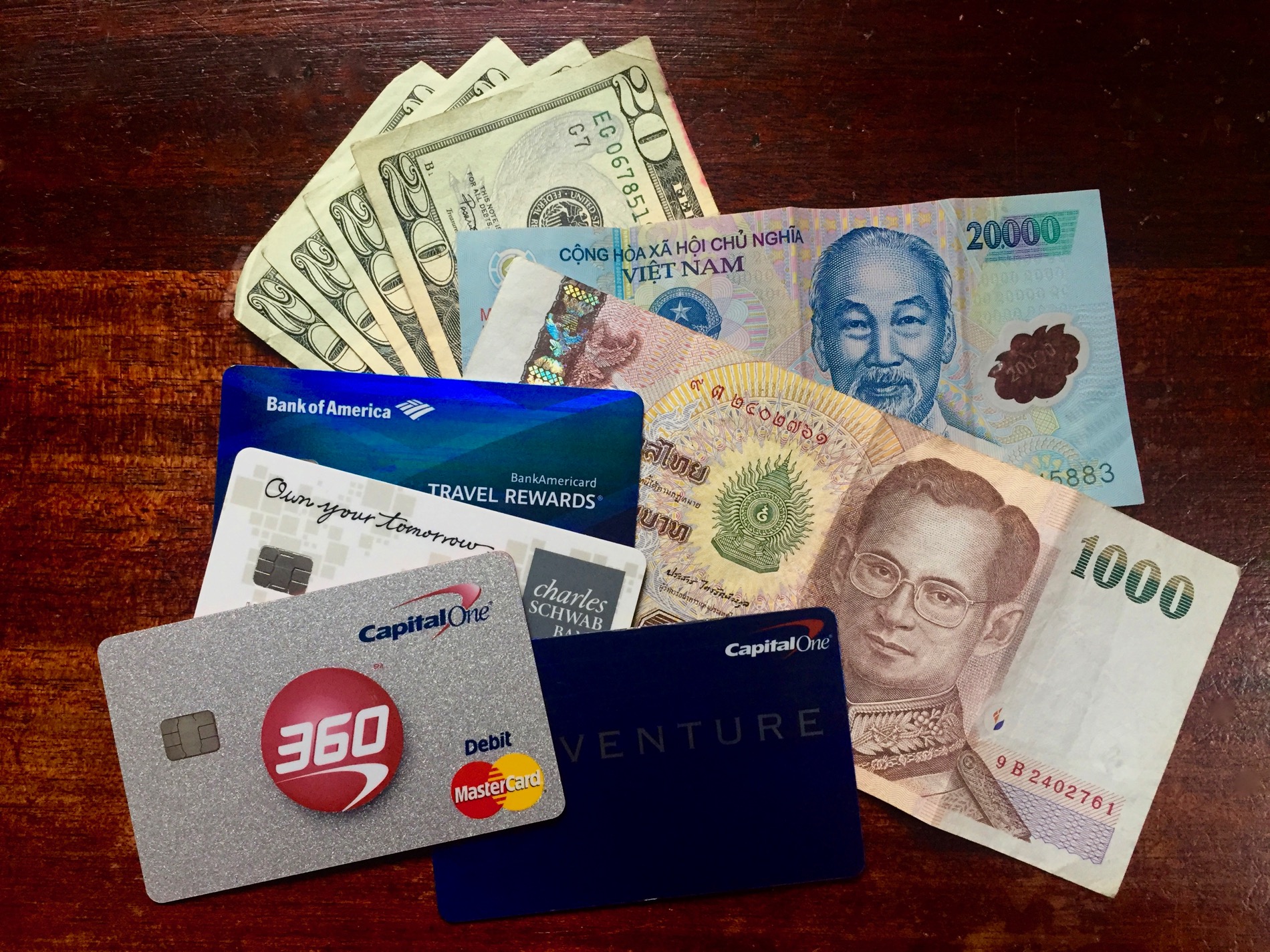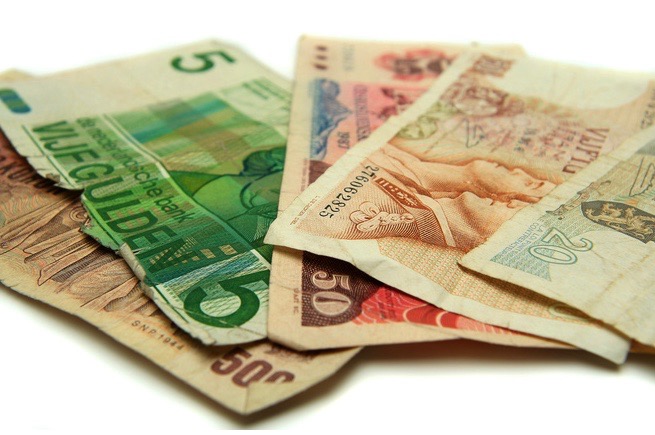Whether planning a getaway or preparing for a extended nomadic lifestyle, you’ll need to set up mobile-friendly banking. The simplest solution to access your money abroad to withdraw cash from ATMs via debit card, in conjunction with credit cards.
My Basic System
1) I kept the bulk of my savings in a high-interest savings or money market account with no transfer fees (for years, I used Capital One). Since the pandemic, where to find higher yield fluctuates.
2) One or two checking/debit accounts, with no foreign transaction fees (preferably one that will refund local ATM fees).
3) At least one travel reward credit card with no foreign transaction fees.
Setting Up
Physical address
You’ll need a legal physical street address to apply for credit cards and bank accounts, so set this up before going mobile by using the address of a family member, or apply for a “Virtual Address” (I use ‘Anytime Mailbox’). A virtual mailbox will receive your mail, scan it, and email you the contents, or forward you packages.
Online banking
Open a bank account online or by phone, then download the bank’s mobile app, and configure notification and billing settings to “Paperless” so you receive future correspondence via email.
Test your system before leaving
Allow plenty of time to gain familiarity and work out the glitches while still in your home country. I tested transfers, debit cards, credit cards, and even points redemption, all before leaving on a two-year vagabond journey.

High Yield Savings, Money Market Accounts, or Stable Coins
Originally I kept the majority of my nest egg in Capital One’s “360 Performance Savings,” a high-interest savings account. Capital One’s customer interface is streamlined and easy to figure out and customer service is good.
Capital One is primarily an online bank. They have a number of brick-and-mortar branches and some deposit-taking ATMs dispersed throughout the USA. If you don’t live close to any of those, you should deposit any large cash reserves into your current bank now, then do an online transfer to get all your funds into Capital One.
Online Checking Account (with no ATM fees)
I use a separate bank for my primary checking/debit account. The best bank for US nomads is Charles Schwab. They’re 100% free: No monthly service fees or account minimums, free bill pay and standard checks, free wire transfers from any major bank, and no foreign transaction fees on debit cards worldwide. Whats more, Charles Schwab reimburses ATM fees at the end of every billing cycle. Local banks (in whatever country you’re traveling) usually charge a fee to use their ATM and these can add up.
To open a Schwab checking account, you must first set up a brokerage account then add the checking account to it. But you don’t have to keep anything in your brokerage account if you don’t want to.
I transfer small amounts from my savings account into my Charles Schwab checking account (keeping my savings secure) to withdraw at ATMs. If I ever lost my Schwab debit card or if the account is compromised in any way, there’s not much in there to lose.
* Interested in opening a Charles Schwab account? I can get you a Bonus Award of up to $500 when you become a new Schwab client and make a qualifying net deposit with this referral link. They will deposit the $500 into your account about a week after the 45-day qualification period. That’s all for you BTW. I don’t make an affiliate cut.
Backup Checking/Debit Account (Optional)
Some people like to keep a backup checking account as a safety precaution (in case an ATM eats the primary debit card or it’s lost/stolen). Packing these two debit cards in separate areas of the luggage is a good idea.
Travel Reward Credit Cards
I wanted a credit card with travel rewards, no foreign transaction fees, and no international conversion fees so that I could use it as freely as I would in the States. Some of the best options are: Chase Sapphire Preferred (or Reserve if you travel enough to warrant the heavier annual fee), Barclay Arrival Plus, and the Capital One “Venture.”
Most of these cards offer bonus miles when you spend a required amount of purchases within the first few months of signing up. So anytime I’m gearing up for a major purchase I’ll take the opportunity to sign up for a new card and gain the bonus sign-up miles. The 40,000 bonus miles I earned from a Capital One Venture card paid for a ticket to Asia.
If you’re new to travel hacking reward points, using the “Purchase Eraser” feature with the Capital One Venture card is simple and straightforward. The card offers 2 reward points per dollar spent on any purchase and the rewards never expire. Any travel-related purchases can be refunded using reward points. The card does have an annual fee which is waived the first year (If you want to avoid the annual fee, get the “VentureOne” instead, which offers fewer points per dollar spent, yet no annual fee).
But if you really get into travel hacking, that purchase eraser becomes less impressive. It’s really just a 2% cashback card limited to travel-related redemptions. You may as well get a 2% cash-back card instead.
Many point-savvy travelers find the best point value credit card is the Chase Sapphire Preferred (You’ll get 100,0000 bonus points using that link) which has an annual fee of $95 (or the Sapphire Reserve with a $450 annual fee). When used in conjunction with Chase Freedom, these Chase cards create a power duo for accruing travel points.
Getting the most out of Chase points redemption isn’t beginner-friendly like Capital One’s Venture Card, which is why I took the Venture with me to India in 2016. After a year on the road, I applied for the Chase Sapphire Preferred followed by the Chase Freedom, then downgraded my Capital One Venture to the Quicksilver (which has no annual fee).
For those who don’t want to deal with annual fees, look into the Capital One Quicksilver or the Bank of America Travel Rewards card which both offer 1.5 points for every dollar spent with no foreign transaction fees and points don’t expire. The BofA offers 20,000 bonus points after spending $1000 in the first three months (which paid for a ticket from Bangkok to Delhi). Another option is the new Capital One ‘Savor One’ which offers 3% Dining/Entertainment, 2% Groceries, 1% everything else). With no annual fee, I can hang onto such cards indefinitely, just use them every so often to keep the card active.
Sending or Accepting Money
Venmo is a great app for transferring money between two participating parties.
Square I ordered a free square credit card reader that plugs into my iPhone on the off chance I need to accept money by credit card. It processes credit card charges through the Square Mobile App and makes deposits directly to my bank account (minus a small fee by Square).
Wise (formerly TransferWise) sends funds from your bank to anyone else’s bank with fees lower than Paypal.

Travel Finance Tips:
- Keep banking info. (account numbers, routing numbers, contact info.) stored in the Cloud so you can access that information from any computer in the unfortunate event that you’re separated from your belongings. You could also send an email to yourself with your bank’s contact information and file that email for later reference.
- When using ATMs abroad, try to use one INSIDE of a bank. If you must use one on the street, check the slot before placing your card into it. Make sure the keypad is real and pull on the whole mechanism to see if it’s loose. If so, don’t use that ATM! It may have a skimmer added. Always cover your hand over the keypad when entering your PIN in case of overhead cameras.
- Don’t hand your credit card to anyone (a waiter for example). They could easily copy your credit card number or swap out the chip. Instead, walk up to register to pay, or remove cash via atm and use cash for payments.
- Most debit/checking accounts have a daily limit to how much cash you can withdraw from an ATM (for Charles Schwab it’s $1000). Keep this in mind when preparing for large cash purchases. Don’t forget to check the exchange rate so you know exactly how many dollars you’re actually withdrawing. I use a currency conversion app on my iPhone (currently using “Convert”).
- Set up automatic payments for all services (Spotify, Netflix, etc…)
- Keep a few hundred dollars in a PayPal account to access for emergencies.
- Always keep enough cash on hand to get yourself to A) an Airport. B) a Hospital. You never know what may occur in a foreign country. When I arrived in India in the middle of a financial crisis, I was unable to remove my own cash from ATMs, leaving me cashless in a country that mostly uses cash.
- In some countries, it’s not safe to walk down the street carrying a purse. Look around, take note of what the locals do and be even more conservative than locals. I like to store valuables under my clothing. These small silk pouches attach to a bra and will hold cash, credit card, and keys, or a running belt that will hold more like a passport, wallet, and keys. These are the exact items that I use:
As an Amazon Associate, I earn from qualified purchases, but I never recommend something that I don’t use myself.


2 thoughts on “Mobile Banking for Travelers & Nomads”
Wow Heather, you really have done your research! I have the Chase card already and the Citi one too so I guess I can go traveling ! Love reading your blog and seeing your travels and adventures!
Awesome Natalie! Sounds like you’re set!